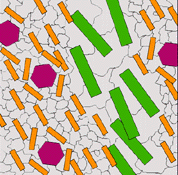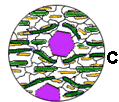| From the information provided above, can the shape of the cross-cutting body reveal its origin?
(Always, sometimes, never) | Shape alone will not distinguish between scenarios 1 through 4. In all four cases, the shapes are fundamentally similar: both sides of the cross-cutting body are parallel to each other. Neither will shape distinguish between scenarios 6 and 7, in which the cross-cutting rock body resembles a 'hill'. Only the cross-cutting rock body in scenario 5 appears unique: it is joined to a horizontal rock layer made of the same material. However, if the horizontal layer was not exposed, and only the vertical, filled fracture was visible, then the shape would resemble those present in scenarios 1 through 4. All one would see would be a cross-cutting body both of whose sides are parallel to each other. |
| Can the mere presence of a zone of distinct character located at the interface between the cross-cutting body and the surrounding rocks serve to reveal its origin? (Always, sometimes, never) | Both scenarios 6 and 7 result in a 'hill-shaped body' surrounded by a distinct, peripheral zone. Only a close look at the texture and mineralogy could distinguish between weathering and metamorphic alteration. |
| Can the texture of the cross-cutting body serve to reveal its origin?
(Always, sometimes, never) | Scenario 4 is highly likely to result in a rock with clastic texture. But the weathered zone in scenario 7 also might have a clastic texture. |
| From your answers to questions 1 through 3, what conclusion can you reach as to whether it is possible to distinguish between the seven different scenarios of origin for cross-cutting relationships on the basis of the information supplied so far? (Always, sometimes, never) | By themselves, the shape of the cross-cutting body, texture, and the presence or absence of a peripheral distinct zone do not provide a unique answer. Perhaps the mineralogy of the rock units (which isn't shown in the diagram) will help. Perhaps, too, the presence of folded rocks adjacent to the cross-cutting body in scenario 1 (not yet discussed) will turn out to be significant. These and other features will be examined next. |
| ----- | ----- |
| From the information provided above, does the hypothesis 'Layers 1 through 3 formed in a sedimentary environment' seem supported? Explain. | Note the primary structures (ripple marks and fossils) in layers 1 and 3. Layer 2 is described as a 'shale'. Presumably the rock displays the poorly slabby character distinctive of shale. Shale is a sedimentary rock.  |
| Does the hypothesis 'The changes observed in layers 1 through 3 as rock body 'A' is approached were imposed by rock body 'A'' seem supported? Explain. | HINT: The development of slaty cleavage in layer 2 indicates the action of pressure.  The orientation of the slaty cleavage suggests that it originated due to a force operating perpendicular to the boundary of the layer with rock body 'A'. If rock body 'A' were emplaced forcibly, the surrounding rocks would be subjected to pressure perpendicular to the boundary. The orientation of the slaty cleavage suggests that it originated due to a force operating perpendicular to the boundary of the layer with rock body 'A'. If rock body 'A' were emplaced forcibly, the surrounding rocks would be subjected to pressure perpendicular to the boundary.The increase in grain size in layers 1 and 3 as rock 'A' is approached is compatible with an increase in temperature. See the experiment on textural effects of heating solid metal.  If rock body 'A' was hot when it formed, it could cause a rise in temperature in the adjacent region. If rock body 'A' was hot when it formed, it could cause a rise in temperature in the adjacent region. |
| Does the hypothesis 'The rocks occupying the 'alteration zone' are metamorphic rocks' seem supported? | HINT: If the arguments for application of pressure and increase in temperature just given are accepted, then the rocks would meet the definition of 'metamorphic'.  |
| Which of the seven scenarios (hypotheses) described above for the formation of a cross-cutting body is most supported for the origin of rock body 'A'? Explain. | HINT: As noted above, the changes in the rocks adjacent to rock 'A' are compatible with a rise in temperature caused by rock 'A'. The increase in grain size from the border to the center of rock body 'A' is compatible with its formation by crystallization of a melt.  |
| How might the absence of an altered zone (visible at the scale of this diagram) along the boundary between the extension of rock body 'A' and rock layers 4 through 8 be explained? | HINT: What relationship is there between the volume of body of melt and the amount of heat it gives off? |
| Nothing has been said about the origin of rock body 'C' nor about the absence of an altered zone along the boundary between rock body 'A' and rock body 'C'. What comments or questions do you have about these matters? | HINT: These are not easy questions. First, review the 'Under Heat and Pressure' rollover.  Compare the last image of the rollover with the circular diagram showing the texture of rock 'C'. The similarity suggests rock 'C' is metamorphic. If rock 'C' is indeed metamorphic, then the heat and pressure imposed upon it by rock 'A' may have had little effect on it. Rock 'C' was formed under conditions of high pressure and temperature and so did not need to change again when rock 'A' was emplaced. Compare the last image of the rollover with the circular diagram showing the texture of rock 'C'. The similarity suggests rock 'C' is metamorphic. If rock 'C' is indeed metamorphic, then the heat and pressure imposed upon it by rock 'A' may have had little effect on it. Rock 'C' was formed under conditions of high pressure and temperature and so did not need to change again when rock 'A' was emplaced.
 
|